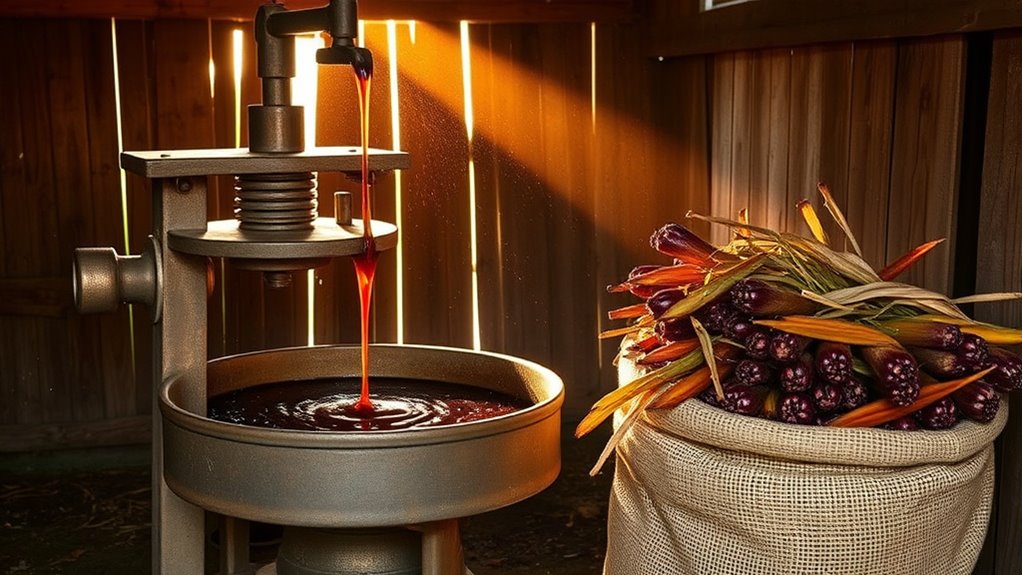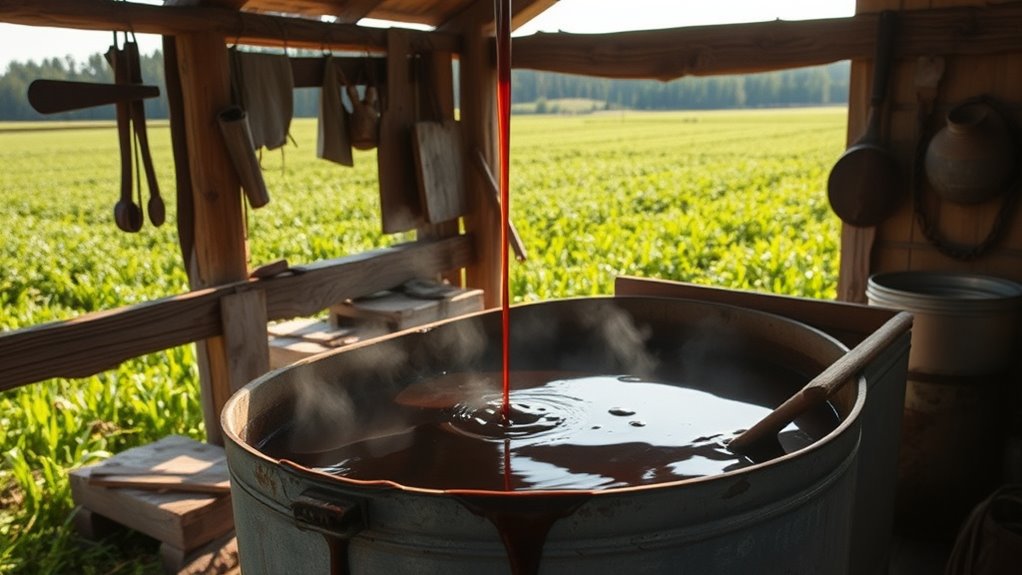Sorghum molasses is making a comeback as a traditional American sweetener rooted in Southern history. This thick, dark syrup offers a rich, earthy flavor that adds depth to baked goods, sauces, and marinades. Unlike refined sugars, it’s less processed and highlights craftsmanship in its production. Its unique taste and cultural significance make it a fascinating alternative. To discover more about its history, uses, and how it’s gaining popularity today, keep exploring this remarkable sweetener.
Key Takeaways
- Sorghum molasses is a traditional Southern sweetener made from boiled-down sorghum juice, offering a rich, bold flavor.
- Its production involves crushing sorghum stalks and boiling the juice, reflecting a labor-intensive, craft-oriented process.
- Once a primary sweetener before refined sugars, sorghum molasses is experiencing a revival due to its historical significance and unique taste.
- It enhances recipes like baked goods, sauces, and glazes with its deep, earthy sweetness and spicy notes.
- Growing interest highlights its cultural heritage, sustainable cultivation, and appreciation for less refined, artisanal sweeteners.

Sorghum molasses, a thick, dark syrup made from boiled-down sorghum juice, has been a staple in Southern kitchens for generations. Its rich, bold flavor once made it a go-to sweetener, especially before refined sugars became widely available. Today, more people are rediscovering sorghum molasses, appreciating its deep history and unique taste. To understand its resurgence, you should first explore sorghum cultivation. Growing sorghum isn’t complicated; it’s a hardy crop that thrives in warm climates and well-drained soil. If you’re interested in making your own sorghum molasses, knowing about sorghum cultivation helps you appreciate the effort involved, from planting to harvest. Once harvested, the juice is extracted, typically by crushing the stalks, and then boiled down to produce molasses. This process is labor-intensive but rewarding, especially when you taste the rich, complex flavors that store-bought versions often lack. Additionally, understanding the drainage requirements of the soil can help ensure a healthy crop and better-quality molasses. Proper soil management is essential for maintaining the health of the plants and maximizing yield.
Sorghum molasses isn’t just a sweetener; it’s an ingredient that adds depth to many recipes. You can incorporate it into traditional molasses recipes like gingerbread, cookies, or barbecue sauces for a distinctive twist. The sweetness of sorghum molasses is less refined than cane sugar or corn syrup, giving your dishes a more nuanced, earthy flavor. It pairs well with spices like cinnamon and ginger, making it perfect for baked goods or glazes. If you’re feeling adventurous, you can experiment with sorghum molasses in marinades or dressings, where its robust character can shine through. Remember, because it’s less processed, sorghum molasses has a thicker consistency and more pronounced flavor, so a little goes a long way.
Frequently Asked Questions
Is Sorghum Molasses Gluten-Free?
Yes, sorghum molasses is gluten-free, making it a great choice for gluten-free baking if you’re managing dietary restrictions. Since it’s made from sorghum grain, it naturally contains no gluten, so you can incorporate it into recipes without worry. Always check labels to verify no cross-contamination, but generally, sorghum molasses is safe for those with gluten sensitivities, helping you enjoy sweet treats without compromising your diet.
How Does Sorghum Molasses Compare Nutritionally to Other Sweeteners?
You might think all sweeteners are the same, but sorghum molasses offers notable nutritional benefits. It’s lower in sugar content than many syrups and contains minerals like calcium and iron, giving it an edge over refined sugars. Unlike processed sweeteners, it’s less likely to spike your blood sugar quickly. So, if you’re seeking a wholesome alternative, sorghum molasses provides a richer nutritional profile without sacrificing sweetness.
What Are Traditional Recipes Using Sorghum Molasses?
You can use sorghum syrup recipes to add rich flavor to traditional southern dishes. It’s perfect for making sorghum pancakes, glazed ham, or BBQ sauces. Many people enjoy drizzling it over biscuits, mixing it into baked beans, or using it as a natural sweetener in cornbread. These recipes highlight its deep, earthy sweetness, making it a versatile ingredient in classic southern cooking that brings a nostalgic touch to your meals.
How Should Sorghum Molasses Be Stored for Maximum Freshness?
To guarantee maximum freshness, you should store sorghum molasses properly. Keep it in an airtight container, preferably in a cool, dark place like a pantry or cellar. Proper storage helps extend its shelf life, preventing spoilage or crystallization. Avoid exposing it to heat or direct sunlight. With good storage, your sorghum molasses can stay fresh for up to a year, preserving its rich flavor and nutritional benefits.
Is Sorghum Molasses Suitable for Vegan Diets?
You might wonder if sorghum molasses fits into vegan diets. Generally, it’s vegan-compatible because it’s made from plant-based sorghum syrup, with no animal products involved. However, always check labels or sources for additives or processing methods that could affect dietary considerations. If you’re mindful of vegan standards, sorghum molasses can be a flavorful, natural sweetener that aligns well with your dietary choices.
Conclusion
As you rediscover sorghum molasses, remember that old habits die hard, but they often make way for new favorites. This sweetener’s rich history and unique flavor make it a true gem worth bringing back to your pantry. Embrace the comeback of sorghum molasses and enjoy its natural sweetness. After all, sometimes the best things in life are the ones we thought we’d forgotten, proving that old treasures can still shine bright.









